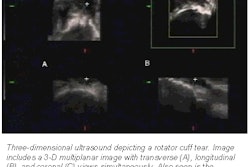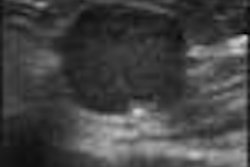(Ultrasound Review) Can ultrasound alone be used for identification of juxtadiaphragmatic lesions with sufficient diagnostic accuracy?
According to researchers from the Hospital for Sick Children in Toronto, "any lesion not demonstrating unequivocal sonographic findings of pulmonary sequestration should undergo further investigation and, if necessary, tissue sampling or excision." They reported the detailed findings of four infants, who were initially diagnosed as having pulmonary sequestration using ultrasound, in Pediatric Radiology.
Grayscale ultrasound has obvious practical advantages in pediatric management because of its non-invasive nature, system mobility, and economic considerations. The supplementary use of Doppler to assess the vascularity of mass lesions "permits this modality to be an excellent potential tool to investigate lesions suspected of being pulmonary sequestrations," the researchers stated.
The characteristic ultrasound findings for pulmonary sequestration include juxtadiaphragmatic mass in infants with an abnormal feeding vessel arising from the aorta.
The four false-positive cases all loosely exhibited these ultrasound findings, but in fact were not pulmonary sequestrations. In one case, the mass echogenicity was heterogeneous and contained calcifications which was not indicative of pulmonary sequestration.
The correct diagnoses for these four cases were infarcted right lower lung, adrenal adenoma, and two cases of neuroblastoma. The authors suggested that the rarity of pulmonary sequestrations made it difficult to perform a comprehensive statistical comparison of the diagnostic accuracy of CT, MRI, and ultrasound.
A search of the current literature by the authors revealed that "prenatally diagnosed congenital pulmonary lesions may undergo spontaneous involution with time." A conservative approach with serial surveillance examinations using ultrasound would seem logical in asymptomatic infants.
However, they concluded that until a thorough analysis is performed to determine the sensitivity of ultrasound in making this diagnosis, initial ultrasound examinations should be followed by tissue sampling or surgical removal when there are questionable findings.
"Pitfalls in the sonographic diagnosis of juxtadiaphragmatic pulmonary sequestrations"David E Manson and Alan Daneman
Department of Diagnostic Imaging, The Hospital for Sick Children, University of Toronto, 555 University Avenue, Toronto, Ontario M5G 1X8, Canada
Pediatric Radiology 2001; (April); 31:260–264
By Ultrasound Review
June 11, 2001
Click here to post your comments about this story. Please include the headline of the article in your message.
Copyright © 2001 AuntMinnie.com



















